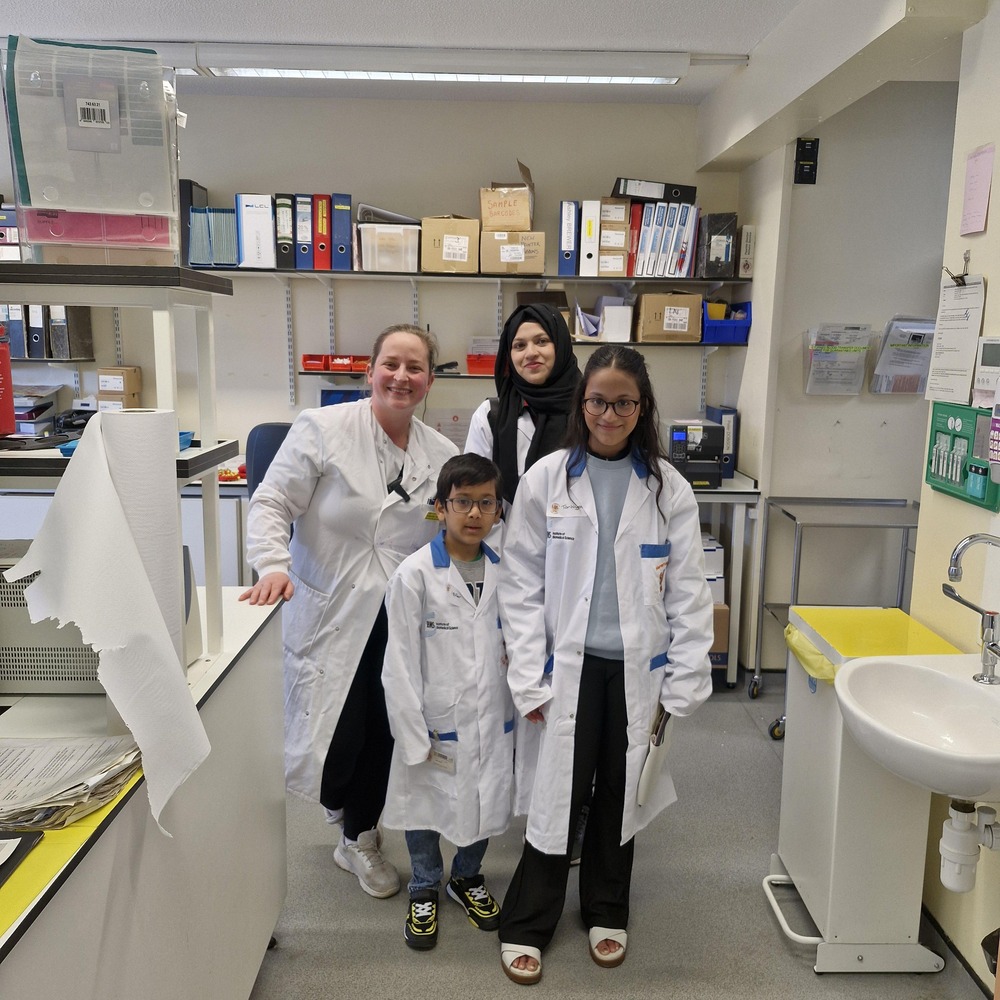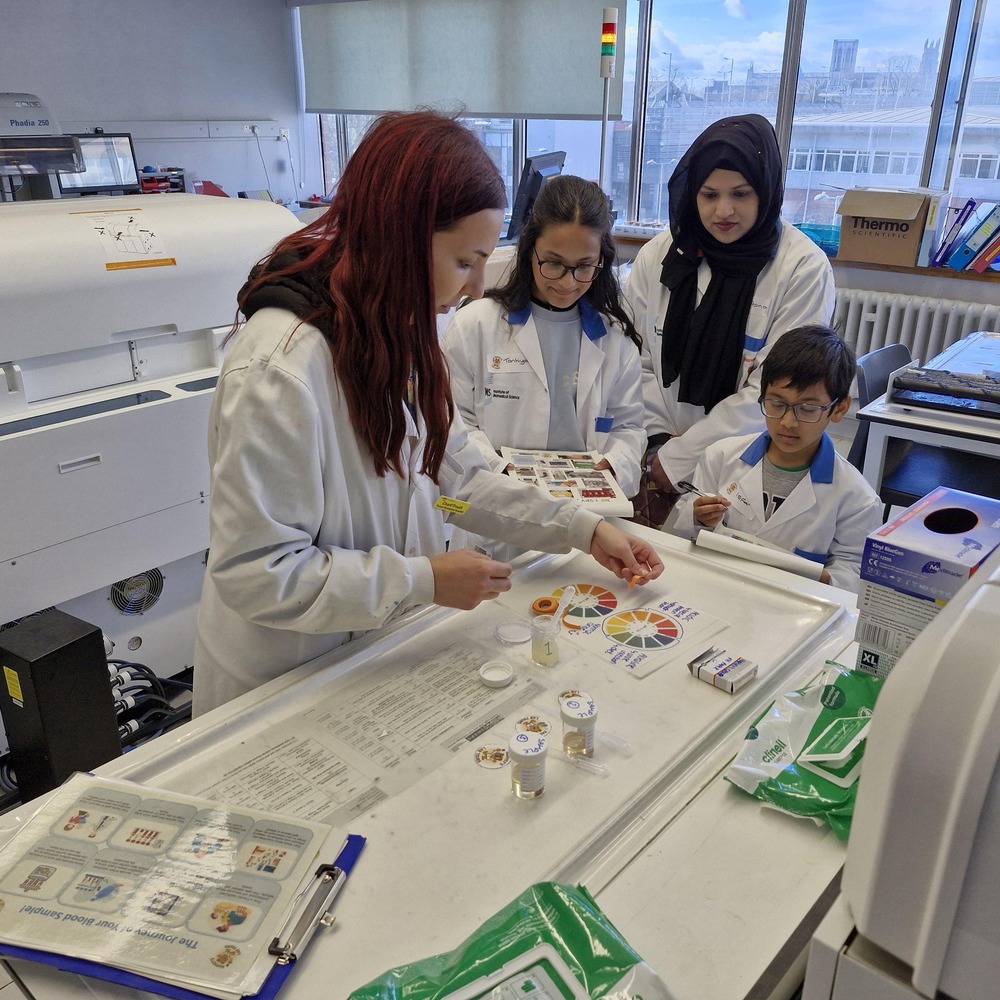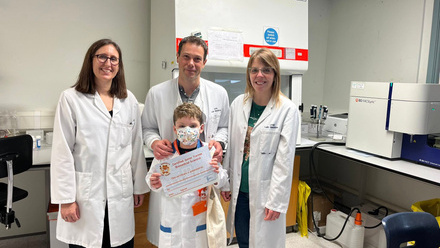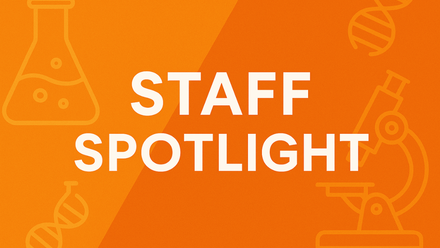“We just wish we had started sooner” - Bringing the Lab to Life at York and Scarborough Teaching Hospital

(Photo features Charli Trouth, who volunteered during the SHYPS tour.)
We caught up with Hasmita Rana, Deputy Training Lead for the Scarborough, Hull and York Pathology Service (SHYPS), about how she and Transfusion Practitioner Tina Ivel worked together to launch the hospital’s very first Harvey’s Lab Tour.
With a background as a Specialist BMS in Biochemistry and experience supporting lab visits, Hasmita saw the project as a perfect opportunity to open laboratory doors to young patients and their families.
I’d just started my new role and thought, this is something I’ve wanted to do for years. Let’s make it happen.
How did you approach planning your first Harvey’s Lab Tour?
Hasmita contacted the IBMS to apply, only to learn Tina had already submitted an application.
It worked out really well. Because of Tina’s role, she already had great connections with the Children’s Ward, which gave us a strong starting point.
From there, Hasmita put out a call for volunteers, and she and Tina arranged a meeting with interested staff and the Children’s Play Specialists.
We invited the Play Specialists on a lab tour first, just to make sure the space was suitable and get their thoughts on which children might benefit. Their feedback was really positive, and they were keen to get families involved.
They also contacted other hospitals already running tours.
We reached out to Dumfries and Galloway and Addenbrooke’s Hospital, both of which already run Harvey’s Lab Tours. They kindly shared activity ideas and tips on how to handle the documentation.
After a few brainstorming sessions, the team ran a pilot tour with four staff members’ children of different ages.
Once we finalised the documents and got approval from management, we ran a pilot tour with staff members' children. Their feedback was very encouraging, with helpful suggestions for improvements as well.
What makes a good lab tour for a young patient?
For Hasmita, a good tour should be practical, interactive and engaging.
Hands-on activities are essential. The children love looking down the microscope, testing the pH of urine, labelling tubes, filling them with fake blood, and centrifuging them. Labelling their own “blood” sample mimics what happens to them during hospital visits, for example, giving them a sense of ownership over something that usually feels out of their control. Interactive games like “I Spy” around the lab also help keep them engaged and make learning fun. We try to simplify complex information and use relatable language to explain how the lab works and how it supports their health, as well as some of the diseases they may have.
The SHYPS team carries out a pre-assessment before each visit to prepare for individual needs, such as sensory or mobility requirements and whether siblings will be attending.
We’re also very attentive to the children’s engagement and mood. If a child is feeling tired or anxious, we slow things down or take a break. We adapt every visit to the child and their family. That’s what makes it meaningful, because we’re not just ticking boxes. We want each child to feel included and supported.

(Photo features Katarina Johnson, who volunteered during the SHYPS tour.)
How important is teamwork across departments when delivering a tour?
Teamwork is everything, and each staff member has a role in making the tours something special. We’ve had volunteers from Transfusion, Haematology, Biochemistry... everyone brings something different to the table.
The Play Specialists are especially helpful. They give lots of insight into the personalities and needs of the children attending, so we can be well-prepared.
According to Hasmita, the team takes time to reflect after each tour, usually debriefing over coffee or lunch. This gives them a chance to talk through what went well and how they can improve.
What kind of preparation happens behind the scenes to make a tour run smoothly?
For Hasmita, preparation makes all the difference.
Tina and I usually lead on the planning, which helps keep things straightforward and stress-free for everyone involved.
A few days before each tour, the team holds a short planning meeting to go over staff roles, discuss the child’s needs and background with input from the Play Specialists, and make sure all departments are informed and ready to welcome the visiting family.
Families are also asked to complete a pre-assessment form ahead of time. This helps the team tailor the visit and make sure all health and safety needs are considered in advance.
To support this process, the team created a detailed Standard Operating Procedure (SOP) for Harvey’s Lab Tours. It includes:
-
A step-by-step guide to planning a tour
-
Risk assessment and safeguarding measures
-
A materials checklist (including lab coats, bags and badges)
-
Templates for certificates and badges
-
QR codes and digital links to make forms quick and easy to complete
On the day itself, the team arrives about an hour early to carry out risk assessments for each department the child will visit and to make sure all materials and equipment are set up and ready.
What challenges did you face getting started?
Hasmita reflects:
One of the biggest challenges was definitely the paperwork, making sure we had everything in place to meet safety and safeguarding standards. Trying to coordinate planning around shift patterns wasn’t easy either.
Her advice?
If I could offer any advice, it would be to take note of the types of documents that might be needed ahead of running tours, like application forms, risk assessments and media consent forms. This will help make the process much smoother for new sites. A standardised information pack could really support this. I’d also recommend reaching out to other labs that have already run Harvey’s Lab Tours to learn from their experiences, especially around the paperwork and planning stages.
Even so, she wouldn’t change a thing.
There’s nothing I’d do differently, we just wish we’d started sooner. It’s something I’ve wanted to do for years, so seeing it all come together has been a very positive moment. It’s a great achievement, especially watching the children enjoy and learn from the experience.
Making an impact
For Hasmita, the most rewarding part of the programme has been reconnecting with the people behind the pathology.
We work behind the scenes and it’s easy to forget there’s a real child behind every sample. These tours remind us of our role in their care.
She’s also been amazed by the feedback from children and families.
We’ve had children share their experience at school, patients who feel less anxious during their next visit, and even siblings who’ve left inspired about science.
One moment stood out especially.
A young patient reminded staff to use the correct blood tube and label it properly. That showed us just how much they’d taken in.
And parents, she says, often leave with a whole new perspective.
Many of them had no idea what was happening behind the scenes. The tour helps them understand the work we do and how it connects to their child’s care.
Advice for other labs
Start with the documents. Get your SOP in place, talk to your safeguarding team, and speak to the children’s ward early. The Play Specialists are your best allies.
She also recommends using digital tools to simplify organisation and encouraging volunteers from across departments.
Involve as many volunteers from different disciplines as possible. It enhances the tour experience but also makes it more engaging for families. Different departments bring unique ideas for activities and practical experiences, adding real value and variety to the overall experience.
Most of all, she encourages labs to share the positive impact with their team.
Sharing feedback with the wider department helps everyone feel part of something meaningful. It’s one of the best things we’ve done.
We would like to thank Hasmita and Tina for sharing their experience and advice. Their story is a reminder that with the right support, collaboration, and a bit of creative thinking, any team can deliver a Harvey’s Lab Tour that makes a real difference.If you’re thinking about getting involved or introducing lab tours to your site, contact [email protected] to find out how you can get started.





